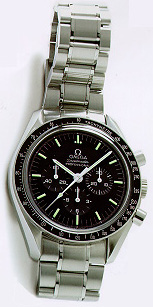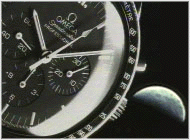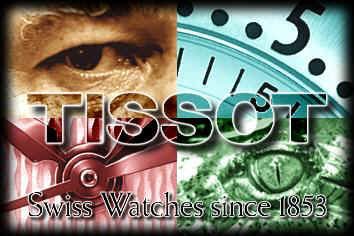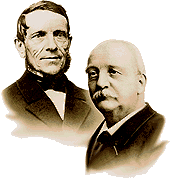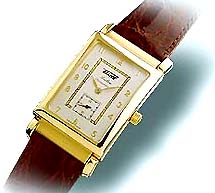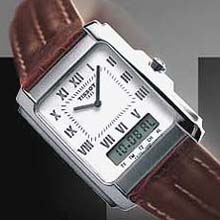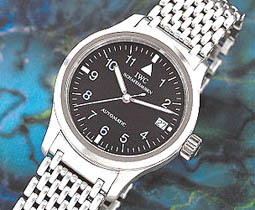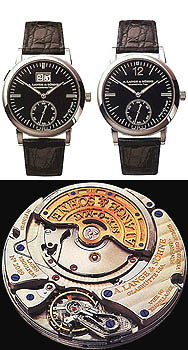Hello
friends!
| My name is Detlef
Stiebeling, and I live in Montreal, Canada.
Although I am a trained art historian (Ph.D. 1986,
McGill - click HERE
if you are in need of an art historian and would
like to see my CV), the great passion of
virtually all my life has been watches, and it
pre-dates my interest in art by many years. I got
my first "good" watch when I was 15
years old, an electronic Tissot
PR 516 GL, which at the
time - pre-quartz - was one of the most accurate
models on the market. It had a transistor chip
which regulated the movement of the balance, and
the only thing more accurate then (1969) were
models marketed by Bulova, which used a tuning
fork instead of a balance, but they were too
expensive for me. |
| As
it was, I had to take a job in construction, at
my age illegally working 10 hours a day for the
whole summer vacation (six weeks then in Germany).
Because of this job (shifts started at 7:30 AM),
I almost missed watching the first moon landing,
which was broadcast very early on TV. The
following year, I read about what was to become
the most radical revolution in the history of the
wristwatch, the first quartz watch. Late in 1972,
HMW, (previously Hamilton Watch Company) of
Lancaster, Pennsylvania, began to sell the Pulsar,
the first all-electronic wristwatch. |
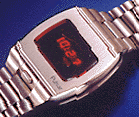 |
| The Pulsar's most
striking feature was its time display. Gone were
the traditional hands and dial. Instead, it
indicated the time of day in flashing red digits
at the push of a button. Advertised as a "Time
Computer" and initially sold in fine jewelry
stores for $2100 (roughly the same price as a
Chevrolet Vega in those years), the costly Pulsar
was one of the earliest consumer products of the
microelectronics revolution. Needless to say, it
became the new object of my dreams, until Texas
Instruments marketed the first affordable quartz
watches. |
| The dream turned into a
nightmare when the Japanese got involved and
nearly wrecked the Swiss watch industry, which
had to face the choice of adapting or perishing.
Pretty soon, all you could get was quartz, until
a wind of conservatism arose in the mid-80s.
People began to realize that quartz watches,
while highly accurately keeping time, were
essentially dead things. Mechanical watches, with
their little hearts beating in rhythm with our
own, saw a revival and the industry began to
recover. During the crisis years, every company
that wanted to survive produced quartz models. I
remember very well following the progress with my
friends, debating whether Rolex would do it (they
did), whether Patek Philippe would give in (they
did). The well known, rather presumptuous slogan
used by Blancpain, "SINCE
1735, THERE HAS NEVER BEEN A QUARTZ BLANCPAIN
WATCH. AND THERE NEVER WILL BE"
is misleading, because when the quartz revolution
began in the 1970's, Blancpain made no watches at
all. Like its great German counterpart, A. Lange
& Söhne, Blancpain had folded and only
existed as a name on paper until being
resurrected with the advent of the mechanical
revolution. |
| Quartz watches are
probably here to stay, although their accuracy
has already been eclipsed by radio-controlled
clocks (naturally, I have one) and their wearable
wristwatch counterparts. These are actually not
watches at all, although they have a quartz
backup, but radio receivers that are tuned in to
an atomic clock (I believe mine is in Colorado),
from which they receive a signal with the exact
time several times a day. There is no need for
adjustments for daylight savings time, and it is
sort of fun to check whether the time signal on
the radio is correct. As you may know, atomic
clocks are at present the most precise way of
measuring time, accurate to within a second in a
million years, and actually more sound than the
Earth's rotation. Although in Europe, radio
controlled watches have been marketed for years -
Junghans has been a pioneer in the field - they
seem slow to catch on in North America. Still, I
believe that in some way and for some purpose,
mechanical watches will continue to be produced.
Despite its flawed precision when compared to
quartz, the mechanical watch stands as a
masterpiece of human ingenuity and craftsmanship.
All that has been said and written about our
greatest works of art, by masters from Phidias to
Michelangelo and Rodin, can be applied with equal
validity to the great timepieces that have been
created in the past few centuries. |
| On the pages to follow (I'm
not sure how far I'll be able to expand this), I
would like to share my love for and interest in
watches with you and look at some of my favorite
things, beginning with some that I either own or
would like to own. If you have any comments or
questions, please do not hesitate to contact me. |
|
